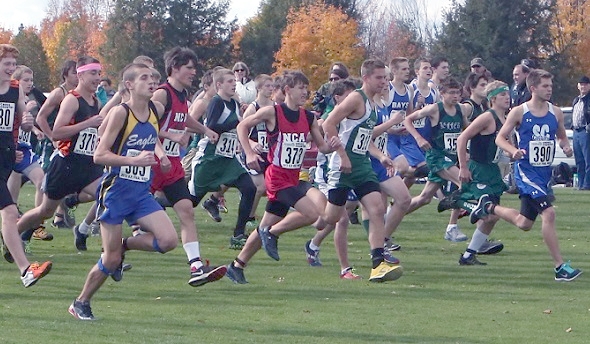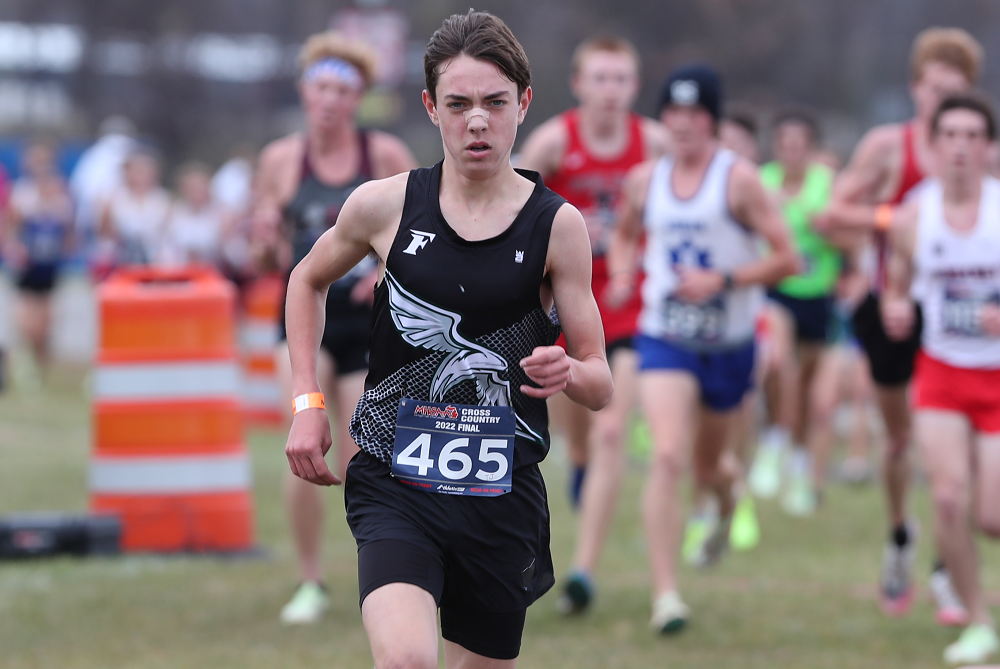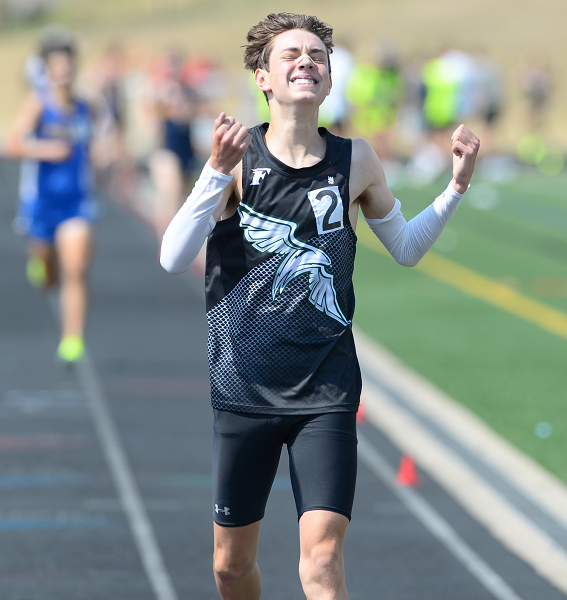
North Central's Jets Blast Off in D3 Final
By
John Vrancic
Special for MHSAA.com
October 19, 2013
HARVEY — Powers North Central coach Jerry Root and Stephenson junior Connor Cappaert were overcome with emotion following Saturday’s Upper Peninsula Cross Country Finals at Gentz’s Homestead Golf Course in Marquette County.
The North Central boys earned their first Division 3 title by edging Pickford 66-68. Third-place Cedarville scored 109 points.
“The whole team stepped up,” said Root, while shedding tears of joy. “These kids worked so hard. They never had a bad attitude one day. To step up the way these kids did today is amazing.”
Cappaert, who was choked up after the meet, captured Division 3 individual honors by covering the 3.1-mile course in 17 minutes, 39 seconds. He was followed by Bessemer junior Zach Mazurek (17:57) and North Central freshman Seth Polfus (18:18) and sophomore Bryce Holle (18:23) on the sunny and seasonably cool day.
“This is so awesome,” said Cappaert, who was crowned Division 2 champion a year ago. “I’ve got to thank God and everyone who supported me. I couldn’t do it without them and our team. Zach really turned it on in this race. The North Central guys ran great, too. I felt a little cramping with a half-mile to go, but I knew I had to keep going. It’s quite an honor being a champion in two divisions.”
For Mazuerk, it was simply a case of trying to stay with the leaders.
“I wanted to stick with the frontrunners and pace myself off them as much as possible,” he said. “Connor had a great race. He went out and took it.”
Polfus admitted he wasn’t sure if the Jets had won right after the meet.
“I thought Pickford or Cedarville had won,” he said. “Then, we saw Mr. Root with a big smile on his face. We knew then we had won it. This is a great day for our team.”
Munising, which captured the title the past two years, didn’t field a complete team this time.
Also, the Mustangs’ ace, sophomore Brett Hannah, slipped to 10th (19:02) after winning a year ago.
Division 1
Marquette captured its first Division 1 title in three years with 42 points, followed by Escanaba 75 and Houghton 86.
Sophomore Lance Rambo led the Redmen by winning in 16:56, followed by senior teammate Cole Rieboldt (18:07) and Houghton junior David Jazsczak (17:22).
“The course was very slippery and the times were slow,” said Rambo. “The water at Mile 2 made it challenging. But the most challenging part was in the end (rolling hills leading into the finish). You just had to push through it.
“It feels real good to win as a team. Our team ran probably one of its best races of the year.”
Rieboldt set a course record (16:22) in his previous outing in the Great Northern Conference meet Oct. 10 on the Dale Fountain Memorial Cross Country Course at Banat (in western Menominee County).
“I went out too fast,” said Rieboldt, who also plays on the school’s soccer team. “This is a tough course, and I was feeling it on the hills. The water at Mile 2 was a hazard. The course was pretty chewed up by the time we got out there. The turns were slippery, too.”
Marquette coach Dale Phillips was impressed with the performance by the team’s leaders.
“It was a two-man race,” he said. “They really ran together. It was just a matter of who had more left in the end. In the majority of the meets we had this year, these guys were 1-2. This is a very, very young team. Five of the seven guys were newcomers to varsity.”
Division 2
St. Ignace was crowned Division 2 champion for the first time with 57 points.
Hancock edged Ishpeming 67-69 for its first runner-up trophy since 1990.
Ironwood junior Jared Joki dominated the race in 17:09, followed by St. Ignace’s Brad Gustafson (18:18) and Andrew Sjogren (18:23).
“I had a pretty good idea I’d have a decent lead,” said Joki, who was crowned Indianhead Conference champion Thursday at neighboring Hurley, Wis., “although, I was mildly surprised by the margin of victory. I tried to follow a conservative approach. I ran a moderate race at the conference meet, so it didn’t affect me too much today. I really like this course and the atmosphere of being at the Finals.”
PHOTO: Runners compete for position early in Saturday's Upper Peninsula Division 3 Final. (Photo courtesy of RunMichigan.com/Paul Gerard.)

Freeland's Hansen Not Focused on Joining All-Time Greats - But On His Way
By
Paul Costanzo
Special for MHSAA.com
September 29, 2023
The goal written on Matt Kaczor’s Post-It Note was sub-15 minutes, 15 seconds. That’s what the Freeland cross country coach was hoping for from star runner TJ Hansen during his junior season.
 Kaczor tore it up after seeing Hansen run a single race this fall.
Kaczor tore it up after seeing Hansen run a single race this fall.
“Knowing what he did over the summer and where he was at, seeing what his 1,600 (meter) and his mile got down to, I had a feeling he could get under 15:30 quickly,” Kaczor said. “After the first race, I looked at my assistant and was like, ‘I’ve gotta rip up that Post-It Note. I don’t think our goal is on the level of where he’s at right now.’ At first, it was break 15:15. Once I saw him race at the Under the Lights (on Aug. 18 at St. Johns), I was like, ‘Yeah, he’s going sub 15.’”
Hansen ran 15:39.6 in that first race, and on Sept. 7, in Shepherd, he ran 15:13.9 to meet the goal written on the now-shredded Post-It Note.
This past Saturday, he ran 15:03.7 at the Cadillac Veterans Serving Veterans Invitational. It’s the fastest time recorded in Michigan this year, and a signal that Kaczor might be filling out a new Post-It Note before the season is out.
“The sub-15 barrier, that’s been something on my mind for a while,” Hansen said. “Now that I’m edging closer and closer to that, it’s been exciting. With how heavy my training has been, I wouldn’t expect (to have run this fast this early). Being able to run the times I am really paints the picture for what’s ahead.”
Hansen came into the season already regarded as one of the elite distance runners in the state. He won the 3,200 meters at the MHSAA Lower Peninsula Division 2 Track & Field Finals this past spring. He’s also finished all-state (12th and fifth, respectively) the past two seasons at the LPD2 Cross Country Finals.
His current trajectory, however, would put his name near some of the state’s all-time greats. But that’s not something Hansen is focusing on.
“I really don’t like to compare myself to others,” he said. “I don’t focus on that. I try to be the best TJ Hansen that I can be. The best version of myself.”
Focusing on himself is almost necessary for Hansen, as he’s spending a lot of time during his races running by himself.
At each of the big events Freeland has run in this season, Hansen has finished at least 20 seconds ahead of his nearest competitor. That includes all divisions of the Duane Raffin Festival of Races in Holly.
In Cadillac, where Hansen ran his current best time, he was a full minute ahead of the rest of the field.
 “He’s just a special athlete,” Kaczor said. “I can’t see Freeland having someone like this in a while. He’s a generational talent. What’s crazy is, I had the school record when he was a freshman. He and Braden (Honsinger) broke it last year. But TJ has now dropped that school record (set in 1998) by almost a minute.”
“He’s just a special athlete,” Kaczor said. “I can’t see Freeland having someone like this in a while. He’s a generational talent. What’s crazy is, I had the school record when he was a freshman. He and Braden (Honsinger) broke it last year. But TJ has now dropped that school record (set in 1998) by almost a minute.”
Hansen’s achievements have already put him on a path to run at the next level, which is something of a family tradition.
His older sisters Peyton and Kiera are track & field athletes at Wayne State and Eastern Michigan, respectively. Their parents, Tim and Pam, were track & field stars at Central Michigan.
TJ has drawn the attention of coaches around the country, including from Michigan, Michigan State, Wisconsin, Tennessee and Colorado.
Having family members who know the process is a help for Hansen, and he said they’ve all been good about allowing him to choose his own path, whatever that may be.
“He’s from a good family that knows how to work and knows how to get things done,” Kaczor said. “He knows that if he puts in the work, he’s going to be at a good spot.”
While Hansen admits it can be a bit overwhelming, he’s using it as motivation to run faster and continue to put his name out there.
Also serving as motivation is 2022 Division 2 champion Connell Alford of Chelsea. Alford is among the elite group of runners in Michigan who have broken the 15-minute mark, doing it twice a year ago.
He currently has the state’s second-best time behind Hansen’s this year, running 15:09.1 at the MSU Invitational on Sept. 15.
“Whenever I see him drop a time, my main goal is to run faster,” Hansen said. “Whenever I see him run a good time, that motivates me to work hard.”
The two won’t see each other until the MHSAA Finals on Nov. 4 at Michigan International Speedway. It’s an opportunity Hansen is excited for, as it’s a chance to race and be pushed toward the lofty goals he’s set for himself. Kaczor is excited about it, too, even if it might mean having to replenish his supply of Post-Its.
“We don’t talk about winning the state title; we talk about making sure that we have great races on those days,” Kaczor said. “We can’t control how somebody else runs. It’s a matter of can we, if the weather is right and the course is in good condition, can we be one of the few guys that has run in the 14s on that course? That’s the goal. Put yourself in some great categories with those upper echelons and the greats of all-time.”
 Paul Costanzo served as a sportswriter at The Port Huron Times Herald from 2006-15, including three years as lead sportswriter, and prior to that as sports editor at the Hillsdale Daily News from 2005-06. He can be reached at [email protected] with story ideas for Genesee, Lapeer, St. Clair, Sanilac, Huron, Tuscola, Saginaw, Bay, Arenac, Midland and Gladwin counties.
Paul Costanzo served as a sportswriter at The Port Huron Times Herald from 2006-15, including three years as lead sportswriter, and prior to that as sports editor at the Hillsdale Daily News from 2005-06. He can be reached at [email protected] with story ideas for Genesee, Lapeer, St. Clair, Sanilac, Huron, Tuscola, Saginaw, Bay, Arenac, Midland and Gladwin counties.
PHOTOS (Top) Freeland's TJ Hansen leads a pack during last season's LPD2 Final at Michigan International Speedway. (Middle) Hansen enjoys a moment of exhilaration after winning the 3,200 this spring at the LPD2 Finals at Ada Forest Hills Eastern. (Top photo by Carter Sherline/Run Michigan; middle photo by Dave McCauley/Run Michigan.)

